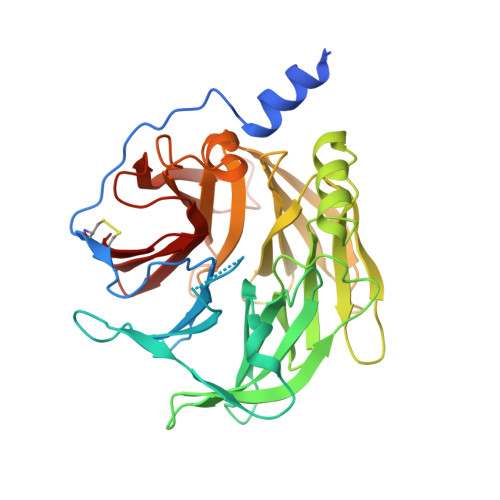Catalytic stimulation by restrained active-site floppiness-the case of high density lipoprotein-bound serum paraoxonase-1.
Ben-David, M., Sussman, J.L., Maxwell, C.I., Szeler, K., Kamerlin, S.C., Tawfik, D.S.(2015) J Mol Biology 427: 1359-1374
- PubMed: 25644661
- DOI: https://doi.org/10.1016/j.jmb.2015.01.013
- Primary Citation of Related Structures:
4Q1U - PubMed Abstract:
Despite the abundance of membrane-associated enzymes, the mechanism by which membrane binding stabilizes these enzymes and stimulates their catalysis remains largely unknown. Serum paraoxonase-1 (PON1) is a lipophilic lactonase whose stability and enzymatic activity are dramatically stimulated when associated with high-density lipoprotein (HDL) particles. Our mutational and structural analyses, combined with empirical valence bond simulations, reveal a network of hydrogen bonds that connect HDL binding residues with Asn168--a key catalytic residue residing >15Å from the HDL contacting interface. This network ensures precise alignment of N168, which, in turn, ligates PON1's catalytic calcium and aligns the lactone substrate for catalysis. HDL binding restrains the overall motion of the active site and particularly of N168, thus reducing the catalytic activation energy barrier. We demonstrate herein that disturbance of this network, even at its most far-reaching periphery, undermines PON1's activity. Membrane binding thus immobilizes long-range interactions via second- and third-shell residues that reduce the active site's floppiness and pre-organize the catalytic residues. Although this network is critical for efficient catalysis, as demonstrated here, unraveling these long-rage interaction networks is challenging, let alone their implementation in artificial enzyme design.
- Department of Structural Biology, Weizmann Institute of Science, Rehovot 76100, Israel; Department of Biological Chemistry, Weizmann Institute of Science, Rehovot 76100, Israel.
Organizational Affiliation:





















